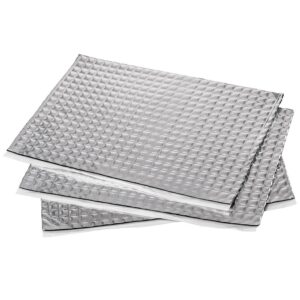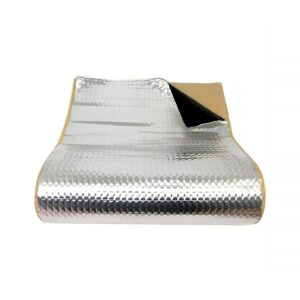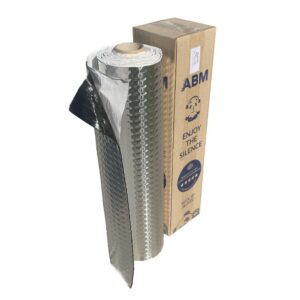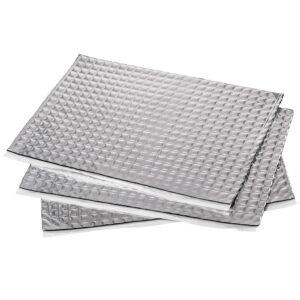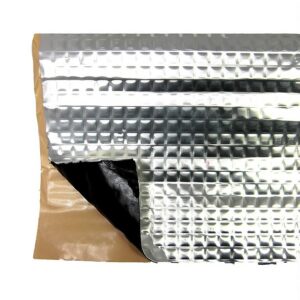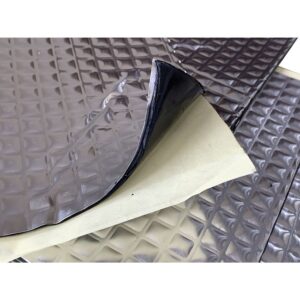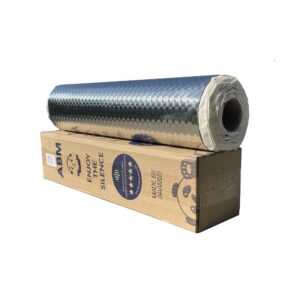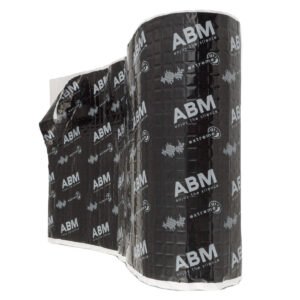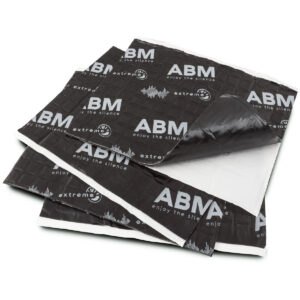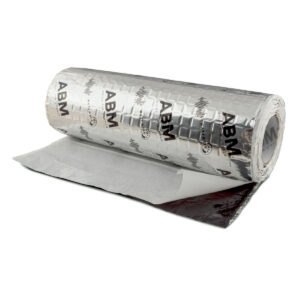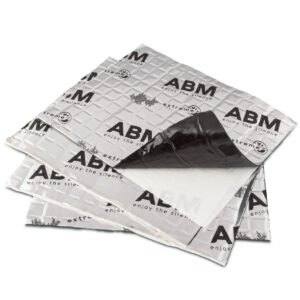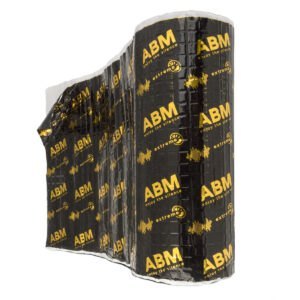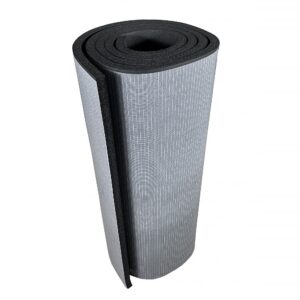Electric cars are becoming an increasingly popular choice among drivers worldwide. However, the quiet operation of electric motors can be misleading. Electric vehicles generate specific noise from different sources.
Soundproofing an electric automobile requires a special approach and appropriate materials. Differences in construction and acoustic characteristics demand a thoughtful strategy. Effective sound insulation improves driving comfort and protects against adverse noise effects.
Modern insulating materials enable significant noise level reduction. Professional solutions guarantee long-lasting acoustic protection. The right product choice ensures an optimal quality-to-price ratio.
Why Electric Cars Require Specialized Acoustic Insulation
Electric vehicles feature a unique acoustic profile that differs from traditional combustion engine cars. The absence of a loud combustion engine reveals previously masked noise sources. Sounds from tires, wind, and mechanical components become more noticeable.
Increased sensitivity to external noise requires more effective cabin insulation. Passengers expect a quiet and comfortable environment during the ride. Specialized insulating materials provide the appropriate level of soundproofing.
Characteristic Noise Sources in Electric Vehicles
Electric cars generate noise from different sources than combustion vehicles. Battery cooling systems and power converters emit high frequencies. Heat pumps and air conditioning compressors operate more intensively than in traditional cars.
Regenerative braking produces distinctive mechanical sounds. Electronic energy management systems generate noises at various frequencies. Battery cooling fans operate in specific temperature cycles.
Vibrations from chassis components transfer directly to the bodywork. Suspension parts and wheel bearings become dominant noise sources. Aerodynamic air rustling is especially audible at higher speeds.
Structural resonances may occur within certain frequency ranges. Different body materials respond differently to specific vibrations. Composite elements require an individual approach to insulation.
The Impact of Construction on Sound Propagation
The construction of electric vehicles differs significantly from their combustion counterparts. The low position of the battery changes mass distribution and vibration characteristics. Central placement of batteries affects how vibrations are transmitted.
Aluminum and composite body parts have different acoustic properties. Structural reinforcements in various locations create new sound propagation paths. High-voltage cable connections can generate electromagnetic interference.
Main areas requiring enhanced insulation:
- Cabin floor above the battery pack
- Partition walls between the engine compartment and the cabin
- Tunnels and high-voltage cable channels
- Acoustic covers for cooling systems
- Suspension components and drive mounting elements
The specific properties of structural materials require tailored insulation solutions. Steel components transmit vibrations differently than aluminum parts. Plastic covers can resonate within certain frequency ranges.
Acoustic standards for electric vehicles
Legal regulations specify maximum noise levels emitted by vehicles. Electric cars must meet the same standards as their combustion engine counterparts. Additionally, requirements for minimum sound levels have been introduced for pedestrian safety.
AVAS (Acoustic Vehicle Alerting System) warning systems must work in harmony with cabin insulation. External sound generators cannot disrupt passenger comfort. Balancing safety and quietness requires precise solutions.
European ECE R51 standards define measurement procedures and noise limits. Tests are conducted under controlled laboratory conditions. Actual operating conditions may differ from standard testing procedures.
Advantages of ABM Xtreme butyl mats for effective soundproofing, energy efficiency, and electric vehicle performance
ABM Xtreme butyl mats represent the highest class of soundproofing materials available on the market. Advanced manufacturing technology ensures optimal vibration and noise reduction. The special multilayer design guarantees maximum effectiveness with minimal weight.
The premium quality of constituent materials translates into long-lasting reliability. The absence of asphalt in the composition eliminates the risk of cracking under extreme temperatures. The non-toxic formula ensures safety for passengers and the environment.
Acoustic and thermal properties
The advanced butyl structure offers exceptional vibration damping effectiveness. The high material density blocks the propagation of acoustic waves through body components. The flexible layer adapts to surface shapes, ensuring full adhesion.
The vibration reduction coefficient exceeds standard materials by 40%. A wide frequency range covers both low and high sounds. Thermodynamic properties help stabilize cabin temperature.
Optimization of energy efficiency
Effective thermal insulation reduces the load on air conditioning systems. Lower heating and cooling demands translate into increased vehicle range. Stable battery temperature improves their performance and lifespan.
The minimal weight of the material does not burden the vehicle structure. Every additional kilogram affects energy consumption in electric vehicles. The optimal mass-to-effectiveness ratio delivers the best results.
Key energy benefits:
- Reduction of energy consumption for air conditioning by 15-25%
- Stabilization of battery temperature within the optimal range
- Increase in vehicle range by more kilometers
- Improvement of battery lifespan through better thermal regulation
- Reduction of load on the heat pump and compressor
Tip: Installing ABM Xtreme butyl mats on the cabin ceiling above the battery pack maximizes energy benefits by thermally insulating the largest heat source in the electric vehicle.
Comparison of ABM Professional and ABM Xtreme Butyl Mat Properties
The two product lines from ABM Insulation offer different levels of technological advancement. ABM Professional provides solid acoustic protection for standard applications. ABM Xtreme represents the most advanced solutions for demanding applications.
The choice of the right product depends on the expected level of soundproofing and budget. Differences in composition and manufacturing technology affect effectiveness and durability. A comparative analysis helps make an optimal purchasing decision.
Comparison of Composition and Technology
ABM Professional uses proven butyl technology with added stabilizers. The aluminum layer thickness is 0.1 mm, providing good corrosion protection. The standard adhesive formula ensures durable adhesion at temperatures from -40°C to 170°C.
ABM Xtreme contains advanced polymers that improve flexibility and adhesion. The reinforced metal layer increases effectiveness in blocking electromagnetic waves. The improved adhesive formula works reliably over a wider temperature range.
| Property | ABM Professional | ABM Xtreme |
|---|---|---|
| Aluminum Layer Thickness | 0.1 mm | 0.12 mm |
| Temperature Range | -40°C to 170°C | -45°C to 180°C |
| Damping Coefficient | Standard | Premium +40% |
| Flexibility | Good | Exceptional |
| Crack Resistance | High | Maximum |
Acoustic Effectiveness in Practice
Laboratory tests demonstrate the superiority of ABM Xtreme in reducing mid-frequency noise. The difference in effectiveness is 3-6 dB in the critical range of 200-2000 Hz. ABM Professional provides satisfactory results in basic automotive applications.
Real-world operating conditions confirm laboratory measurements. Electric vehicles require top-class materials due to the nature of the generated noise. Investing in ABM Xtreme pays off through long-lasting effectiveness and user comfort.
Tip: For premium electric vehicles, it is recommended to use ABM Xtreme in key areas such as the cabin floor and partition walls, while ABM Professional is suitable for less critical areas like wheel wells.
ABM Rubber Insulation Foams in a Multilayer Acoustic Protection System
Rubber foams are an essential component of a comprehensive soundproofing system for electric vehicles. The closed-cell structure provides effective absorption of high-frequency sound waves. The material’s flexibility allows filling irregular spaces and gaps.
The combination of butyl mats with rubber foams creates a synergistic acoustic effect. The first layer dampens structural vibrations while the second absorbs sound waves. Multilayer solutions achieve the highest level of soundproofing effectiveness.
Mechanism of Action of Rubber Foams
The closed air cells within the material’s structure act as microscopic dampers. Sound waves lose energy as they pass through numerous cell partitions. The process of converting acoustic energy into heat ensures effective noise reduction.
Density and cell size influence the frequency characteristics of absorption. Smaller cells more effectively dampen high frequencies typical for electronic systems. Larger cells handle mid-range frequencies originating from mechanical components better.
Applications in Electric Vehicles
ABM rubber foams are ideal for areas requiring flexible insulation. Irregular shapes of battery cells and high-voltage wiring require material adaptability. The self-adhesive layer simplifies installation in hard-to-reach places.
Resistance to moisture and chemicals ensures long-term effectiveness under automotive conditions. The material does not absorb odors nor support mold growth. Self-extinguishing properties enhance vehicle fire safety.
Optimal uses for rubber foams:
- Soundproofing battery cells and cooling systems
- Insulating high-voltage wiring tunnels
- Damping resonances in body cavities
- Absorbing sounds from ventilation systems
- Filling spaces between structural components
The thermal insulation properties of the foams support vehicle energy efficiency. Stabilizing the temperature of electronic components improves their reliability. Reducing thermal gradients minimizes mechanical stresses within the structure.
Tip: A 19 mm thick rubber foam is optimal for most applications in electric vehicles, providing a balance between acoustic effectiveness and space-saving installation.
Optimal Thickness of Rubber Foams for Different Zones of an Electric Vehicle
The choice of the appropriate rubber foam thickness determines the effectiveness of soundproofing and cost efficiency. Different areas of the vehicle require an individual approach due to the specific nature of the noise generated. Acoustic analysis helps in the optimal selection of materials.
Foams that are too thin do not provide effective low-frequency absorption. Excessive thickness increases weight and cost without proportional acoustic improvement. Balancing effectiveness and practicality requires application experience.
Engine and Drive Systems Zone
The drive compartment of electric vehicles requires foams with a thickness of 25-50 mm due to intense vibrations. Cooling systems and power converters generate a wide frequency spectrum. Thicker foams better dampen low frequencies coming from fans.
High temperatures in the drive compartment demand foams with increased thermal resistance. Direct proximity to heating elements may exceed standard temperature limits. Special thermostable formulations maintain properties under extreme conditions.
Passenger Cabin and Trunk Compartment
The passenger space requires foams with a thickness of 6-19 mm adapted to available space. The cabin walls and floor benefit from thinner layers due to spatial constraints. The ceiling can accommodate thicker foams without affecting ergonomics.
Battery Compartment and High-Voltage Systems
Specific safety requirements limit material choices in the battery zone. Foams with a thickness of 12-25 mm provide effective insulation while maintaining regulatory clearances. Self-extinguishing properties are mandatory in high-voltage applications.
Recommended thicknesses for individual zones:
- Drive compartment: 25-50 mm
- Cabin floor: 12-19 mm
- Cabin walls: 6-12 mm
- Cabin ceiling: 19-25 mm
- Battery compartment: 12-25 mm
- Wheel arches: 19-32 mm
Economic aspects of thickness selection affect the total cost of soundproofing. Progressive cost increases at greater thicknesses require profitability analysis. The optimal point is usually within the mid-range of available options.
Tip: Combining different thicknesses in one vehicle allows for cost optimization – using thinner foams in less critical areas and thicker ones where most needed can reduce the total cost by 20-30%.
Materials for Effective Soundproofing at ABM Insulation Store
ABM Insulation offers a comprehensive range of materials designed for professional soundproofing of electric vehicles. Many years of industry experience translate into high product quality and professional technical advice. Located in Zabki near Warsaw, it ensures fast delivery throughout Poland.
The manufacturer offers a five-year warranty on its products, demonstrating confidence in their quality. The materials have been tested in over 40,000 vehicles worldwide. Quality certificates and safety approvals confirm high production standards.
ABM Professional Butyl Mats
ABM Professional Butyl Mats are a proven solution for standard automotive applications. A high-quality natural butyl layer provides effective vibration reduction. The 0.1 mm thick aluminum layer guarantees corrosion protection and electromagnetic wave reflection.
The self-adhesive layer allows easy installation without heating. The material’s flexibility enables fitting to complex body shapes. The operating temperature range from -40°C to 170°C covers all service conditions.
Available thicknesses of 2.0 mm and 2.5 mm allow adaptation to specific requirements. Sheets measuring 50×200 cm and 50×400 cm ensure optimal installation efficiency. Rolls offer flexibility for large surface areas.
Butyl Soundproofing Mats ABM Professional in the ABM Insulation store
ABM Xtreme Butyl Mats
ABM Xtreme represents the highest class of soundproofing materials offered by the company. The advanced butyl formula includes additives that improve flexibility and adhesion. A reinforced metal layer with a thickness of 0.12 mm enhances electromagnetic shielding effectiveness.
The improved adhesive layer performs reliably at temperatures from -45°C to 180°C. Vibration damping effectiveness is increased by 40% compared to standard materials. Asphalt-free composition eliminates cracking risk and ensures product eco-friendliness.
Premium quality translates into long-lasting reliability under the toughest conditions. The material is ideal for luxury electric vehicles requiring the highest level of soundproofing. Availability in various formats enables project cost optimization.
Butyl Soundproofing Mats ABM Xtreme in the ABM Insulation store
ABM Xtreme Premium Self-adhesive Butyl Soundproofing Mat in rolls, 2.5mm, 2m2
Acoustic Butyl Mat Self-adhesive ABM Xtreme Premium in rolls, 2.0mm, 2m2
ABM Insulation Rubber Foams
ABM Rubber Foams feature a closed-cell structure that ensures effective sound absorption. The high material density guarantees long-lasting acoustic properties. Resistance to moisture, chemicals, and odors ensures reliability in automotive conditions.
The self-adhesive layer simplifies installation in hard-to-reach areas. Self-extinguishing properties enhance vehicle fire safety. Thermal insulation characteristics support the energy efficiency of electric vehicles.
Available thicknesses from 6 mm to 50 mm cover all automotive applications. Standard sheet sizes of 50×100 cm and 100×100 cm provide optimal material efficiency. Custom formats available upon request for specialized uses.
Comprehensive insulation solutions:
- Professional Butyl Mats – basic vibration protection
- Xtreme Butyl Mats – premium vibration and EMI reduction
- Foams 6-12 mm – high-frequency absorption
- Foams 19-25 mm – universal broadband absorption
- Foams 32-50 mm – deep low-frequency damping
Insulation Rubber Foams in the ABM Insulation store
Soundproofing rubber foam with aluminum foil ABM – 10mm, 1m2
Technical Support and Consulting
The experienced technical team at ABM Insulation offers professional advice on material selection. Analyzing the vehicle’s specifics and acoustic requirements allows for solution optimization. Installation instructions and application tips ensure project success in noise reduction.
Contact the Technical Department before purchase to prepare an optimal set of materials tailored to the specific electric vehicle model and project budget.
Comprehensive Installation Process of Insulation Materials in Electric Vehicles
Professional installation of insulation materials requires a systematic approach and knowledge of electric vehicle specifics. Safety when working with high-voltage systems is a priority. Proper operation sequencing ensures optimal effectiveness and durability of the installation.
Preparing the vehicle and tools is a key stage of the entire process. Removing equipment components must consider the specifics of electrical systems. Thorough surface cleaning guarantees durable adhesion of insulation materials.
Vehicle Preparation and Safety
Disconnecting the high-voltage system according to manufacturer procedures is mandatory. Removing the service key and waiting the recommended time for capacitor discharge. Insulating wires and marking safe work zones.
Removing interior equipment components requires caution due to delicate electronic parts. Protecting connectors and control modules from dust and moisture. Preparing adequate work lighting for tasks in dark areas.
Material Application Strategy
Starting with areas that have the greatest acoustic potential ensures the best effect-to-effort ratio. The cabin floor above the battery pack is a priority intervention area. Partition walls between the drivetrain and the cabin require special attention.
Use butyl mats on metal surfaces that transmit vibrations. Supplement with rubber foams in areas requiring sound absorption. Combining different materials maximizes the acoustic effectiveness of the system.
Installation Techniques for Individual Materials
Butyl mats require careful surface cleaning and removal of corrosion traces. Application at a minimum temperature of 8°C for optimal adhesion. Pressing with a roller or special tool ensures full contact with the substrate.
Rubber foams are installed after completing the installation of butyl mats. Filling gaps and irregular spaces requires precise cutting. Avoid excessive compression of the material, which can reduce acoustic effectiveness.
Installation sequence in an electric vehicle:
- Vehicle preparation and safety systems
- Removal of interior equipment components
- Cleaning and surface preparation
- Installation of butyl mats on the cabin floor
- Insulation of partition walls and tunnels
- Installation of foam in empty spaces
- Installation of additional layers in critical areas
- Quality control and leak testing
- Reinstallation of interior equipment components
- Functional testing and acoustic measurements
Quality control of installation includes checking adhesion of all elements. Leak testing of ventilation and air conditioning systems after modifications. Acoustic measurements confirm the effectiveness of applied solutions.
Tip: Documenting the installation process with photographs helps in quality control and can be useful for potential warranty repairs—especially important when working with authorized electric vehicle service centers.
Summary
Effective soundproofing of an electric car requires a specialized approach that considers the unique acoustic characteristics of such vehicles. The combination of high-quality ABM Insulation butyl mats with rubber foams creates a comprehensive noise protection system. Proper selection of thickness and strategic placement of materials ensures optimal effectiveness at reasonable costs.
An investment in professional insulation materials translates not only into driving comfort but also into vehicle energy efficiency. ABM Insulation offers proven solutions backed by years of experience and quality guarantees. A comprehensive installation process carried out according to recommendations ensures long-lasting effectiveness of the soundproofing system.
The choice of appropriate materials and professional installation are key success factors for soundproofing projects. Electric vehicles deserve the highest quality acoustic solutions that highlight their luxurious character and technological advancement.


